Understanding your Engagement Levels
Your Engagement Levels are more than just a good metric of how many people your community has at different stages of involvement, the shape they make will often show you potential problems you have in the community onboarding process. Ideally you want to provide a nice, smooth process for members to reach the level of engagement they want to be at, neither pushing them further nor blocking them from getting there.
Below are some of the shapes you might see in your Engagement Levels chart, and what they mean for your community.
Visitor Heavy

Every community member starts out as a Visitor, the default threshold is a single conversation, so this is always going to be your largest level. Even in a healthy community there will be a large number of people who never progress past this level, they come and ask one question and leave as soon as it’s answered. But ideally you want to keep people around and move them on to being active Participants in your community.
If your Engagement Levels chart looks like this, it means people aren’t seeing value in sticking around in your community, and you need to think about what your community has to offer them beyond transactional support.
Core Heavy
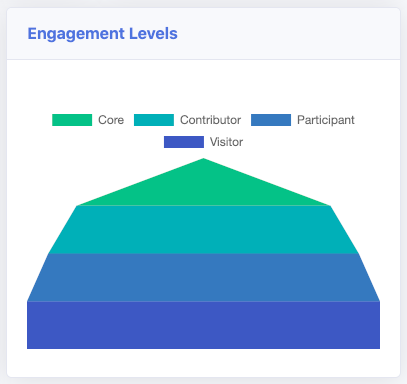
The opposite situation is when you have too many Core member. It may seem counter-intuitive that you could have too many Core members, since the goal is always to level people up in your community, right? But when you have too large a percentage of your community at this level it indicates that you’re not serving members who aren’t ready to be there yet. Your community should offer value at all levels, not just the top most level, otherwise you’re going to struggle to grow it.
If your Engagement Levels chart looks like this, it means your community probably feels out of reach to anybody who isn’t willing or able to become a Core member, and you need to look into ways to make it more welcoming to more casual participants and one-off contributors.
Participation Bottleneck
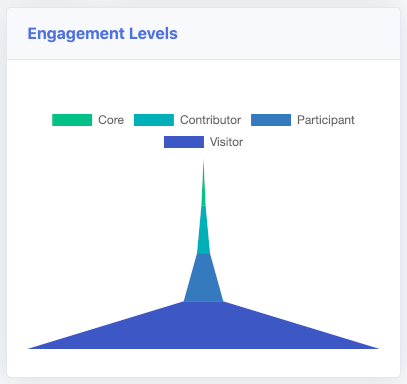
A common situation is that your community is broadly healthy, but has unseen bottlenecks that are preventing members from progressing from one level to the next when they’re ready. These bottlenecks are noticable in your Engagement Levels chart when there is a significant difference between two levels, but smooth transitions between the others.
The most common of these bottlenecks is between Visitors and Participants. If you have a big difference here, but not between Particpants and Contributors, or Contributors and Core, it means that something is keeping people at the Visitor level even when they’re ready to progress up. This can often be overcome by focusing on re-engagement efforts like ensuring somebody is responding to questions or pull requests, sending follow-up emails with updates or reminders relevant to thier initial activity, or even something as simple as sending them a direct message asking if they’ve received the help that they needed.
Contribution Bottleneck
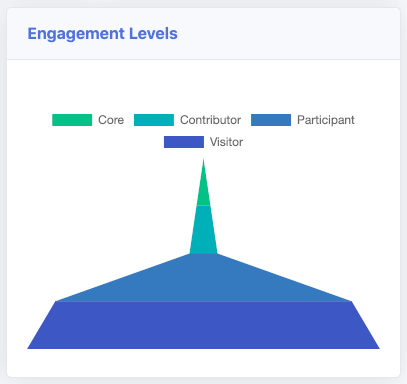
Another common place your community may be bottlenecked is making the jump to being a Contributor. If your community is focused primarily on users talking to other users this might be expected, and not necessarily an indication of a problems. But even in user communities you want people who are giving back more than just conversations, this is why Savannah will look as members providing answers and help to other members and count those as a contribution in addition to more traditional ones like fixing bugs in software.
If you have a bottleneck between your Participants and Contributors, it means your member are lacking either the skills necessary to make a contribution or, more likely, the access needed make them. If you have a user-oriented community, do your members feel empowered to provide support themselves? If you have a product-oriented community are there processes or tools that potential contributors are excluded from? You may need to spend some time talking to your community members to find the answers to these questions, but doing so will unlock the potential for future growth.
Core Bottleneck

The last place your members might be experiencing a bottleneck is in becoming a Core contributor to your community. Since this level requires a significant level of time and effort only a small part of your overall community will ever reach it, but it’s still important make sure you haven’t put any unnecessary obstacles in the way or given such an unpleasant experience on the first contribution that your members don’t want to make more.
If you see a bottleneck here you should take a look at the contribution experience that your members are having. Either the tools, process, or people involved may be giving a poor experience, making first time contributors less likely to go through it again. Read the conversations around their contributions, are they fighting with a tool or process that you could improve or document better? Are people acting as gatekeepers and making the contribution process harder than it needs to be? Ensuring a good first contribution experience is essential if you want members to keep doing it.
Ideal Distributions
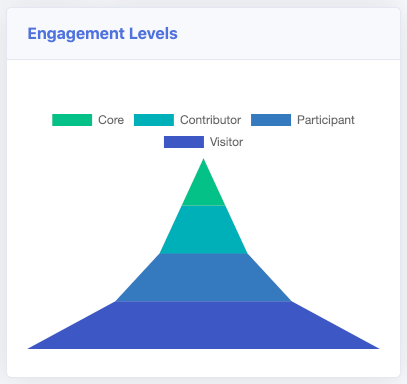
A healthy community will have a relatively consistent difference between the number of members at each level, because every member will move up at their own pace and to their own limits. While the absolute numbers will vary depending on the size of your community, the health and member experience will always show up in your Engagement Levels chart as smooth transitions between levels.
Even with an ideal distribution of members at all levels, there is still some insights to be gained by looking at the overall shape of your graph.
Steep Onramp
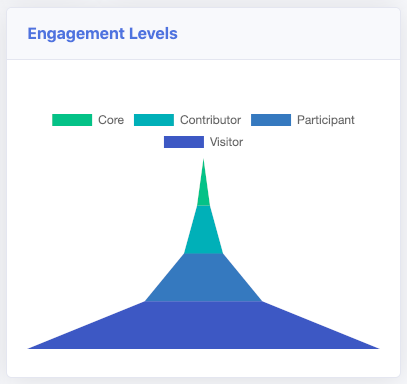
If your community is based on specific knowledge or skills that take significant time or money to acquire, you’re very likely to have a steep onramp for moving members up to higher levels. There’s not much you can do about that other than try to make those skills easier or cheaper to acquire. But if those aren’t needed, there may be changes you can make to your tools or processes to make that progress easier on your members.
Shallow Onramp

A shallow onramp means that your community is progressing easily and quickly up the levels. If your community is based on broadly held skills or interests, you are more likely have a shallow onramp, but if you have a skills-based community it might be a sign that you’re not reaching as many potential Visitors as you could be, and that you need to look into promoting your community more broadly than you currently are.